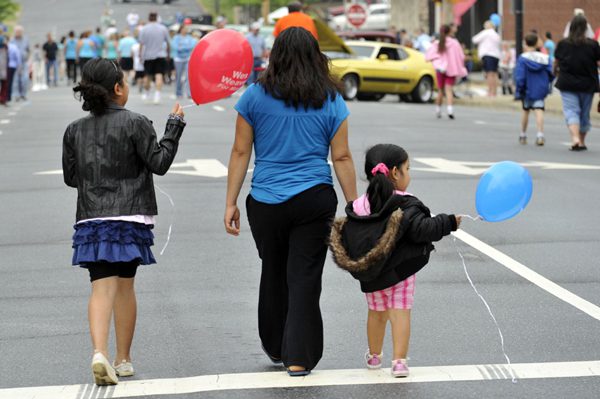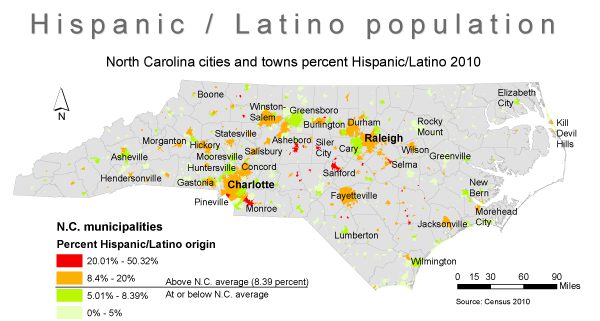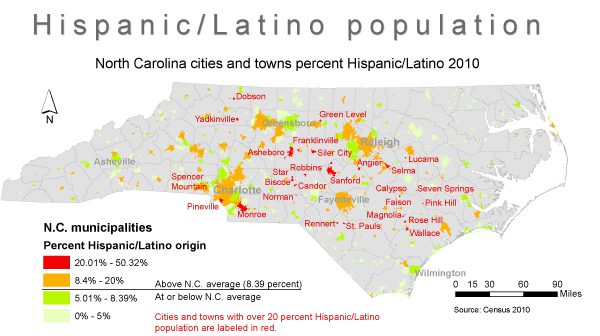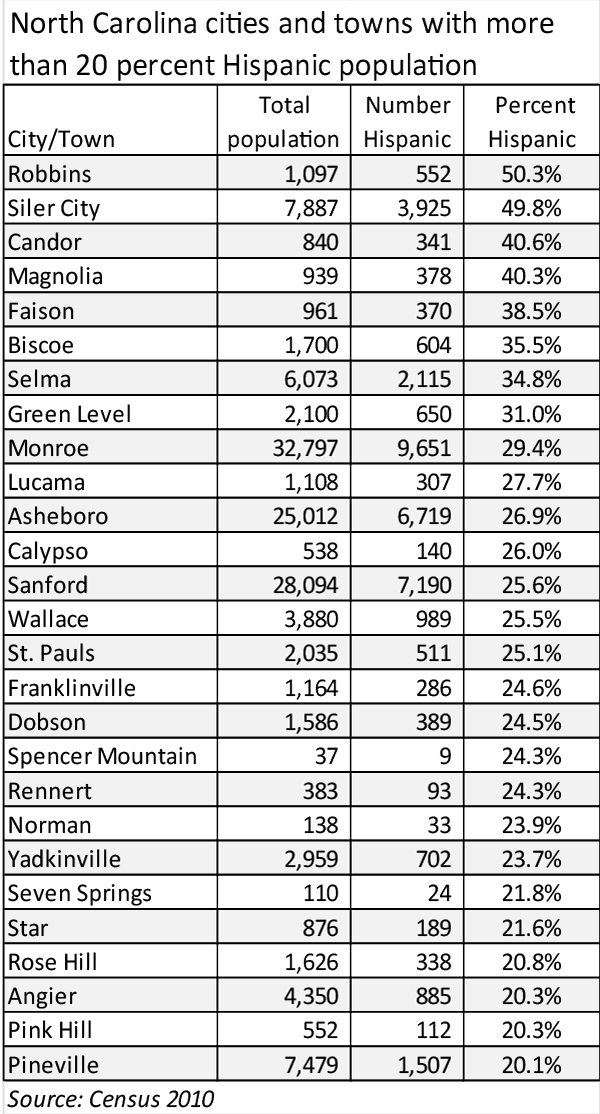Hispanics in N.C.: Big numbers in small towns

In 2000, Hispanic/Latinos accounted for only 4.71 percent of the N.C. population. By 2010 the percentage was 8.39, making the state’s rate of Hispanic growth sixth-fastest in the nation. The latest data show that trend is continuing, with the Hispanic population growing from 8.39 to 8.6 percent from 2010 to 2011.* This continuing increase in Hispanic population has been an important part of growth in urban areas in the state – but Hispanics aren’t the only group contributing to the increase in those cities’ population. For a number of smaller towns, however, the recent growth of Hispanic population has made the difference between growth and decline.
North Carolina’s Hispanic population is a little more than half the percentage in of the U.S. overall (16 percent for the U.S compared to 8.39 percent in North Carolina in 2010). However, many towns across the state meet or exceed the U.S. percentage. North Carolina’s average percentage of Hispanic population is highest in a set of small and medium-sized towns scattered around the state. The map below shows the Hispanic/Latino population percentage among North Carolina’s cities and towns in 2010.

Of the largest cities, Winston-Salem had the highest Hispanic population in 2010 with 14.7 percent. Nearby Greensboro was the largest city in the state to be below the N.C. average, at 7.5 percent. Charlotte (13 percent) and Durham (14.2 percent) are similar to Winston-Salem. Raleigh was also above the state average at 11.4 percent. Several larger suburban communities like Huntersville, Mooresville and Cary are below the state average, as are Asheville and Wilmington. Cities and towns in northeastern North Carolina contain the fewest Hispanic residents.
The second map labels all towns across the state that have a population that’s more than 20 percent Hispanic.

Robbins, in northern Moore County, and Siler City in western Chatham County are approximately 50 percent Hispanic. Asheboro (26.9 percent), Monroe (29.4 percent) and Sanford (25.6 percent) are the largest towns in the state with Hispanic populations of more than 20 percent. Several towns with populations less than 1,000 have Hispanic populations of around 40 percent. (The table below lists all towns with 20 percent or more Hispanic population.)
 Siler City is in the heart of some of the highest-percentage Hispanic towns in the state. With a population of 6,966 in 2000, the town had grown to 7,887 by 2010. The Hispanic population grew from a little less than 40 percent in 2000 to nearly 50 percent in 2010.
Siler City is in the heart of some of the highest-percentage Hispanic towns in the state. With a population of 6,966 in 2000, the town had grown to 7,887 by 2010. The Hispanic population grew from a little less than 40 percent in 2000 to nearly 50 percent in 2010.
Owen Furuseth, associate provost for Metropolitan Studies and Extended Academic Programs at UNC Charlotte, has done extensive work on the topic of community change associated with Latino immigration. He made several observations about the geographic distribution seen here:
What is striking to me about the data are two broad patterns. First, the highest percentages of Hispanics are overly represented in small towns and cities across the state. From the foothills to the coastal plain, Hispanics are an important ethnic group in rural places. And, I suspect without Hispanic in-migration many of these small towns would be emptying out, losing population. Hispanics play an important role in many economic needs of rural N.C. statewide.
Two, Hispanics are urban North Carolinians. The largest number of Hispanics live in the largest cities in the state. They are increasingly moving from rural to urban areas, or moving to cities from other states or international locations.
Why? Greater economic opportunities, higher quality of life issues and joining friends and family.
Late in the 20th century, Hispanics were concentrated in rural North Carolina. Today, they are a part of urban and suburban North Carolina.
–John Chesser
Laura Simmons assisted with research for this article.
*Source: 2010 Census, and 2011 Census estimate.